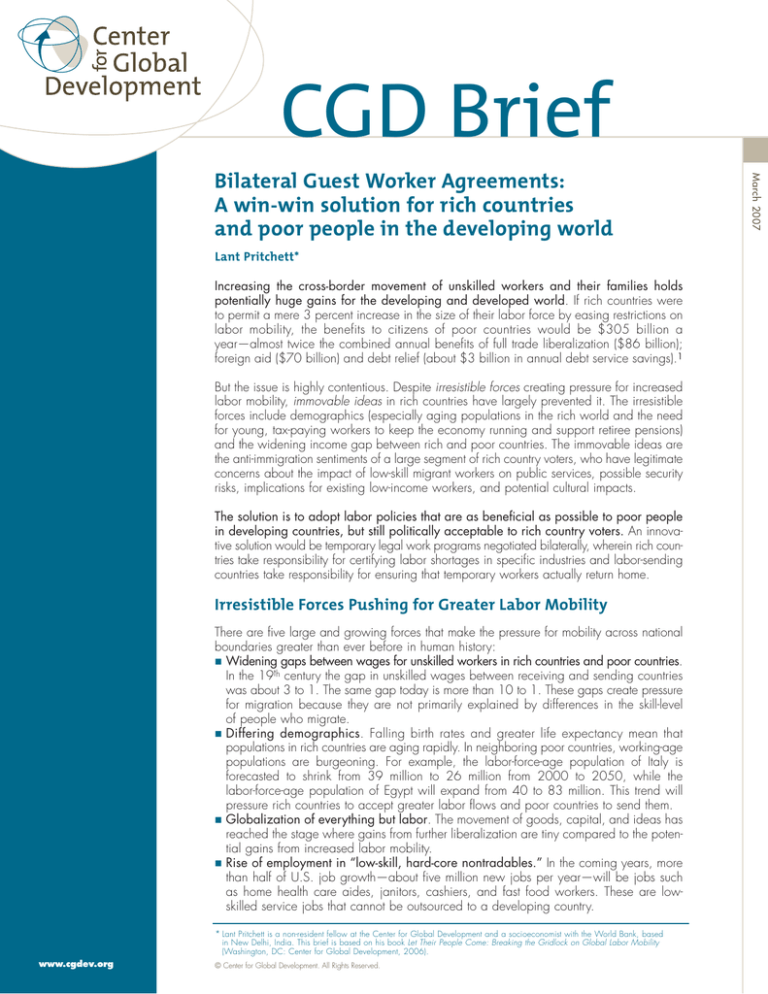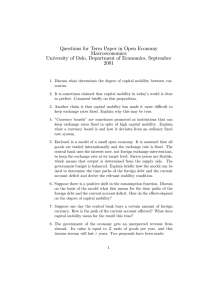
CGD Brief
Lant Pritchett*
Increasing the cross-border movement of unskilled workers and their families holds
potentially huge gains for the developing and developed world. If rich countries were
to permit a mere 3 percent increase in the size of their labor force by easing restrictions on
labor mobility, the benefits to citizens of poor countries would be $305 billion a
year—almost twice the combined annual benefits of full trade liberalization ($86 billion);
foreign aid ($70 billion) and debt relief (about $3 billion in annual debt service savings).1
But the issue is highly contentious. Despite irresistible forces creating pressure for increased
labor mobility, immovable ideas in rich countries have largely prevented it. The irresistible
forces include demographics (especially aging populations in the rich world and the need
for young, tax-paying workers to keep the economy running and support retiree pensions)
and the widening income gap between rich and poor countries. The immovable ideas are
the anti-immigration sentiments of a large segment of rich country voters, who have legitimate
concerns about the impact of low-skill migrant workers on public services, possible security
risks, implications for existing low-income workers, and potential cultural impacts.
The solution is to adopt labor policies that are as beneficial as possible to poor people
in developing countries, but still politically acceptable to rich country voters. An innovative solution would be temporary legal work programs negotiated bilaterally, wherein rich countries take responsibility for certifying labor shortages in specific industries and labor-sending
countries take responsibility for ensuring that temporary workers actually return home.
Irresistible Forces Pushing for Greater Labor Mobility
There are five large and growing forces that make the pressure for mobility across national
boundaries greater than ever before in human history:
Widening gaps between wages for unskilled workers in rich countries and poor countries.
In the 19th century the gap in unskilled wages between receiving and sending countries
was about 3 to 1. The same gap today is more than 10 to 1. These gaps create pressure
for migration because they are not primarily explained by differences in the skill-level
of people who migrate.
Differing demographics. Falling birth rates and greater life expectancy mean that
populations in rich countries are aging rapidly. In neighboring poor countries, working-age
populations are burgeoning. For example, the labor-force-age population of Italy is
forecasted to shrink from 39 million to 26 million from 2000 to 2050, while the
labor-force-age population of Egypt will expand from 40 to 83 million. This trend will
pressure rich countries to accept greater labor flows and poor countries to send them.
Globalization of everything but labor. The movement of goods, capital, and ideas has
reached the stage where gains from further liberalization are tiny compared to the potential gains from increased labor mobility.
Rise of employment in “low-skill, hard-core nontradables.” In the coming years, more
than half of U.S. job growth—about five million new jobs per year—will be jobs such
as home health care aides, janitors, cashiers, and fast food workers. These are lowskilled service jobs that cannot be outsourced to a developing country.
* Lant Pritchett is a non-resident fellow at the Center for Global Development and a socioeconomist with the World Bank, based
in New Delhi, India. This brief is based on his book Let Their People Come: Breaking the Gridlock on Global Labor Mobility
(Washington, DC: Center for Global Development, 2006).
www.cgdev.org
© Center for Global Development. All Rights Reserved.
March 2007
Bilateral Guest Worker Agreements:
A win-win solution for rich countries
and poor people in the developing world
Figure 1. A 3 Percent Increase in Labor Mobility Would Be Worth $305 Billion
a Year to Poor People: More than Aid, Trade and Debt Relief Combined
Let Their People Come: Breaking the Gridlock on Global Labor Mobility
2
Source: see Pritchett 2006.
Lagging growth in “ghost countries.” If labor demand
declines in a region whose workers are mobile, this will
lead to outward migration and “ghost” towns. If labor
demand declines in a region whose workers are not able
to leave, income from relatives working abroad is often the
only way to maintain or improve their standard of living.
Immovable Ideas: Anti-Migration
Sentiments
The five powerful forces pushing for the greater movement
of people have created some increases in migration, but
only a small fraction of the potential. This is mainly because
in nearly all rich countries, migration is highly unpopular.
In opinion surveys, fewer than one in ten people in
high-income countries favor increased immigration.
This opposition to labor mobility is based on eight immovable
ideas—immovable because they are difficult and painful to
address head-on because they often go to very fundamental
notions of justice and equity:
Nationality is a morally legitimate basis for discrimination. It is widely regarded as morally illegitimate to limit
people’s life chances because they were born a woman,
are of a minority race or ethnicity, were raised in a
certain religion, or have a physical disability. And yet it
is considered permissible to discriminate based on
where a person was born.
Moral obligations to others are based on proximity,
that is, whether or not the person lives within the same
political jurisdiction. As long as a specific Haitian is suffering physically in Haiti, the moral obligation of the U.S.
is nothing, or next to nothing. But if that same Haitian
manages to arrive on the soil of the U.S., the moral
obligation to that same person increases almost infinitely.
Development is about improving the well-being of
nations, not individual people. This idea says that labor
mobility is not necessary to raise living standards in
developing countries and may actually hurt them,
through the “brain drain”—by having developing
countries best and brightest move away.
Increased migration will hurt unskilled labor in rich countries,
lowering wages (or taking jobs away from natives) and
worsening the distribution of income in receiving countries.
Unlike many of the other ideas, this idea—grounded in
simple supply and demand—is almost certainly true. This
concern must be addressed; it’s impact must be mitigated
by good policy.
Migrants strain public budgets, because they cost
more in services than they pay in taxes.
Allowing increased movement across borders increases
the risks of crime and terrorism.
“They” are not like “us.” Many worry about “culture
clash,” that the physical presence of others who do not
share the same value systems would undermine the
“cultural cohesion” of the existing society.
Making the movement of labor work:
Temporary worker programs
Any solution to the migration debate must take into account
each of these concerns in order to be politically feasible.
One development-friendly and politically feasible scheme
is to expand legal channels for poor people from
developing countries to work temporarily at low-skill jobs.
This would include several features:
Receiving countries certify labor shortages in specific
industries. Quotas could be set by governments (by
occupation and/or region) based on requests from
employers, who would need to demonstrate a labor
Table 1. Immovable Ideas: Public views on migration
3
March 2007
Source: Mayda 2002, based on International Social Survey Program, national identity module, 1995, and the World Values Survey data on “open borders.”
market shortage by showing that a certain number of jobs
could not be filled. Requests for quotas would be subject
to public review, including possible challenges from labor
unions and other interested parties. This feature will help
to address fears that unskilled foreign workers take jobs
away from low-income citizens.
Sending countries ensure their workers return home. In
order to ensure that temporary workers really return home
when their stay is over, receiving countries would reduce
the sending country’s future quota by one worker for each
worker who fails to return home as scheduled.
Temporary worker programs governed by bilateral
agreements. Rich countries should enter into bilateral
agreements with developing countries to govern
temporary labor. Agreements between just two countries,
or between small groups of countries, will be
more politically acceptable than an overall agreement
through a large multilateral organization such as the
World Trade Organization.
Removing citizenship from the equation. It is widely
accepted for skilled labor that a “temporary physical
presence” to provide services does not imply claims
on social benefits—the acquisition of citizenship or
entitlements to publicly provided services. To address
the concern that temporary workers strain public
budgets by using public services while not paying
taxes, legitimate legal distinctions can be made about
the use of non-essential services. In countries like the
United States with a large population of undocumented
workers, the issue of the future legal status of the
existing migrants also must be addressed as part of a
comprehensive reform.
Protection of the fundamental human rights of
migrants. To be politically acceptable in rich countries,
programs need to emphasize that people coming to perform unskilled labor are not making “tragic choices” out
of economic desperation, but are making positive choices
in which their dignity and rights are maintained.
Benefits of increased labor mobility
Both rich and poor countries benefit when rich economies
admit low-skilled workers. In Hong Kong and Singapore,
for example, foreigners working as housekeepers and nannies
account for 7 percent of the labor force (compared to only
0.3 percent in the U.S.).2 These temporary household workers
make it possible for more highly skilled women to work
outside the home, raising national income by between 1.3
and 3.3 percent, and increasing tax revenues from the
additional employment.
Globally, because of such benefits, a 3 percent increase
in rich country labor forces through legal, temporary labor
would result in a net annual gain of $56 billion to current
rich country residents, on top of the $305 billion annual
direct gain to migrant workers themselves and their families.
And while labor mobility is not always seen as a development issue, it should be. With huge differentials incomes
for equally productive people simply because of where
they live; with international and internal migration offering
individuals one of the few nearly sure-fire ways to escape
poverty, with migrant remittances from rich to poor countries
exceeding foreign aid; and with rich countries designing
immigration policies to selectively attract the poor world’s
most talented and motivated people—with all this it is obvious
that international migration and global labor mobility truly
are “development” issues.
Given the tremendous gains to be had from greater labor
mobility—gains that far outweigh the risks—the international
community should work to find a development-friendly and
politically feasible solution. Because the main forces blocking
increased labor mobility are ideas, the most important
agenda is to create new ideas—proposals that create
development-friendly policies toward migration and create
sustained pressure for the adoption of these proposals.
Endnotes
1 Other estimates, which make different assumptions about rich-country labor
markets, find benefits of $156 billion for a pain of $7 billion to permanent
residents of rich countries.
2 These estimates are based on Michael Kremer and Stanley Watt,
“The Globalization of Household Production,” Harvard University, 2006.
Further Reading
Clemens, Michael. New Data on African Health Professionals Abroad. CGD Working Paper 95.
Washington, DC: Center for Global Development, 2007.
Dervis, Kemal and Ceren Özer. A Better Globalization: Legitimacy, Governance, and Reform.
Washington, DC: Center for Global Development, 2005.
Kapur, Devesh and John McHale. Give Us Your Best and Brightest: The Global Hunt for Talent and
Its Impact on the Developing World. Washington, DC: Center for Global Development, 2005.
Pritchett, Lant. Let Their People Come: Breaking the Gridlock on Global Labor Mobility.
Washington, DC: Center for Global Development, 2006.
Why Global Development Matters for the U.S. CGD Rich World Poor World Brief.
Washington, DC: Center for Global Development 2006.
1776 Massachusetts Ave., NW
Third Floor
Washington, D.C. 20036
www.cgdev.org
CGD Brief
Bilateral Guest Worker Agreements: A win-win solution
for rich countries and poor people in the developing world
Lant Pritchett
March 2007






